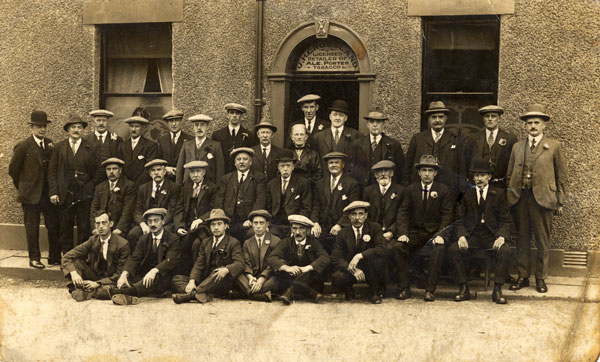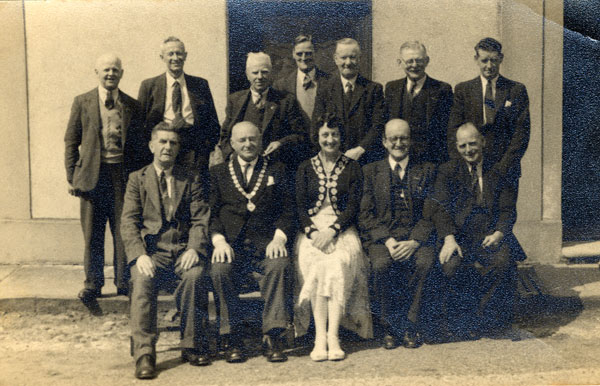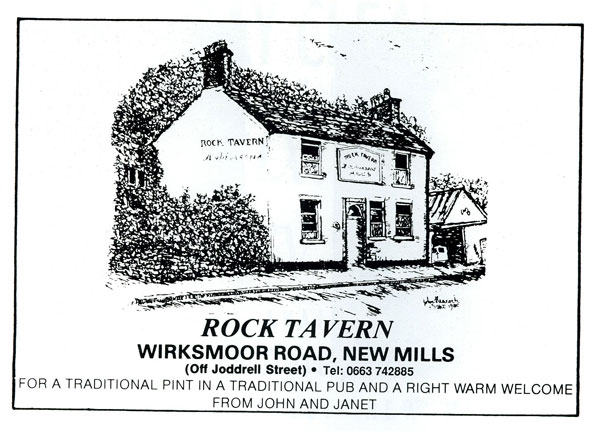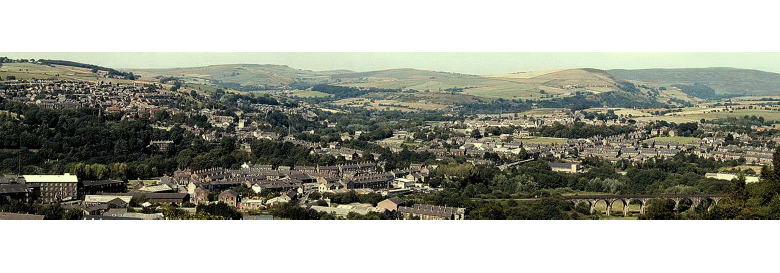Rock Tavern, Wirksmoor Road
In the late 18th century, the boundary between the counties of Derbyshire and Cheshire largely followed the course of the river Goyt through New Mills. The area know today as Newtown was then a wholly rural area of wooded slopes and pasture leading down to the river Goyt, known as Warksmoor (now spelt Wirksmoor). It was then part of the parish of Disley and lay within the boundary of the county of Cheshire.
The earliest detailed map, the 1851 Cheshire Tithe Map illustrates the rural nature of the Warksmoor, there are though some features we can still see today. The Peak Forest Canal, which opened in 1797, would have been visible, as would the 1803 Buxton to Manchester (A6), and the 1835 Hayfield turnpike roads.
The only other road across the Warksmoor was Redmoor Lane. This was the one of the oldest pre-industrial routes of the area. Leading down from Longside in a near straight line, crossing the 1803 Buxton road, before bridging the Peak Forest Canal and crossing the Thornsett turnpike road. The Redmoor Lane then followed the course of the present Wirksmoor road, passing the Rock Tavern before turning into the Torrs to cross the river Goyt by the low level bridge.
The 1851 Tithe map also shows that very few buildings stood on the Warksmoor at that time, only the Grove Mill and its row of cottages, the Torr Vale Mill, an early Warksmoor Mill. The original Warksmoor House, stood on Hurst Lee opposite a building that was to become the present day Rock Tavern, but at this time was a house and garden, and a house and small holding, that would later become the home of the Queens Arms.
It is impossible to accurately date the year when a building first appeared on the site of the Rock Tavern. But it is likely that it appeared at an early date.
The present building, standing as it does within the original footprint, aside the original road through the Warksmoor, is quite possibly the oldest standing residential site in the Newtown area. The only other standing structures of the same or potentially greater age are sections of Torr Vale Mill (1788), the former public house known as The Swan, but originally called “The Swan with Two Necks,” which was built aside the 1803 Buxton turnpike road and is contemporary with it, and the house of Sarah Etchells, which eventually became the Queens Arms.
The original Warksmoor House, which stood opposite the Rock Tavern was built and occupied by notable local mill owner Samuel Schofield, who in 1804 opened Torr Mill at the confluence of the rivers Goyt and Sett. Torr Mill would become the largest of the mills within the Torrs and remained in the ownership of the Schofield family until it was destroyed by fire in 1912. Warksmoor House was undoubtedly built by Schofield at the top of the road leading to the mill in order that he could live close to his business, but away from his workforce who would have been largely drawn from New Mills.
It seems fair to assume that Schofield would not have encouraged a house to have been constructed opposite his own imposing dwelling, and therefore it seems likely that the house and garden opposite predate Schofields 1804 Warksmoor House.
However, the earliest reliable detail for the Rock Tavern comes from the 1851 Tithe Map at this date the building was owned by John and Mathew Sheldon and occupied by Mr. Robert Hibbert and his family. Following the death of Samuel Schofield in 1830, John Sheldon had become tenant of both Torr Mill and Warksmoor House. But following a devastating fire at the mill in 1838, which largely destroyed the mill. Sheldon had bought the slightly smaller house opposite. By the time of the 1851 census the Sheldon family had moved on, but still owned the house and were renting it to Mr. Robert Hibbert and his family.
Robert Hibbert, age 43, a Cotton Manufacturer, his wife Harriet and their children, John age 17, a book keeper, Robert age 14, a scholar, Harriet Ann, age 4, a scholar, Elizabeth, age 3 and Caroline, age 1.
In the late 1840’s Robert Hibbert and Co. a firm of candlewick makers and cotton waste dealers had begun renting part of Torr Vale Mill. However, in 1850, Hibbert had begun the building of his own factory the Warksmoor Mill. It was the first mill in the New Mills area to be built aside the Peak Forest Canal, rather than on the banks of the river. The old reliance on waterpower having by this date been largely replaced by more efficient and powerful steam engines. Robert Hibbert was a man of vision. He saw the transport advantages offered to his business of building a mill close to the canal and the major highway to Manchester. He may also have been speculating on the course of any future railway between Stockport and Buxton. But Robert’s vision went further than his own business needs; he foresaw a new industrial town growing up on the Warksmoor. To further this vision he built a terrace of seventeen houses close to his mill and named them the Newtown Buildings, when asked why, he replied, because there would be a ‘new town’ built there some day and so it proved. Today the Newtown Buildings form Hibbert Street. The railway arrived in 1857, making Newtown as it became know, the fastest growing commercial area in the district. In 1884, the high level Union Bridge between New Mills and Newtown opened across the Torrs gorge and the two towns became physically linked. Though Newtown was to remain in Cheshire until the boundary changes of 1936.
In 1857, Robert Hibbert and his family moved into one of his own Newtown Buildings. The vacant house and garden were taken over by Thomas and Mary Hart, who opened the lower rooms as a public house, which they named the Rock Tavern.
Thirty two year old Thomas and his wife Mary were both natives of Disley. Thomas, the son of a calico printer, was the eldest of five children. He had grown up on of Crescent Row and began his working life as a Crofter, presumably at Disley Printworks. Before the introduction of chemical bleaching raw linen was given repeated soakings in a solution of potash and lime (bowking) before been laid out on the grass in small fields or crofts, for the sun to bleach. The workers carrying out this task were known in the printing trade as crofters. Material hung out in this way was vulnerable to theft, which was a capital offence, a man was convicted and hung and gibbeted near Lyme Cage, for stealing linen from the croft at Strines Printworks.
Thomas and his wife must have been successful, because they continued to run the Rock Tavern for some thirty years, during which time much of the Newtown we know today grew up on the Warksmoor. Several more mills were built along the canal and new streets and rows of houses were built to house the workers, even the Warksmoor changed its name and became more commonly called Wirksmoor. But the biggest change they saw would have been the building of the Union Bridge in 1884. Perhaps it was the change to trade the bridge and the new road brought that prompted them to give up the tavern in 1888.
The next Inn Keeper was Thomas Wood, who with his wife and family moved into the Rock Tavern in the summer of 1888. Forty eight year old Thomas was a native of New Mills; his wife Sophia was a native of Whitehall, near Chinley. Their three children, who had all been born in Newtown, were Annie, age 20, who acted as housekeeper and sons Arthur, age 17 and Herbert, age 14, who were both mill operatives. Tavern in the summer of 1888. Forty eight year old Thomas was a native of New Mills; his wife Sophia was a native of Whitehall, near Chinley. Their three children, who had all been born in Newtown, were Annie, age 20, who acted as housekeeper and sons Arthur, age 17 and Herbert, age 14, who were both mill operatives.
Around 1900, Thomas and Sophia were joined in the business by their son Herbert, who continued to live at the tavern with his wife Sarah and their young son Walter.
Thomas Wood died on the 22nd September 1903 and was buried at the St. Georges Wesleyan Burial Ground. On the 21st of November, Mrs. Sophia Wood was granted the license of the Rock Tavern. Sophia continued as landlady assisted by her son and daughter-in-law until her death in April 1908, age 68, she had been landlady for over twenty years.
Later that year the Rock Tavern was taken over by Mr. Joseph Henry Crossland and his wife Jane. Apart from running a successful public house, Joseph was also the pioneer of the Taxi - Cab in New Mills. So successful was his taxi-cab and car hire business that Joseph.jpg) had a garage built next to the tavern to house his vehicles. He later expanded the garage and began offering spares and repairs. had a garage built next to the tavern to house his vehicles. He later expanded the garage and began offering spares and repairs.
In August 1914, the First World War began in Europe and many of the patrons of the Rock Tavern joined the forces.
An interesting report from 1919, gives an insight into one of the ways the Rock Tavern’s customers supported those of their number who had volunteered or been called to serve their country.
“During the war the customers of the Rock Tavern established a cigarette fund amongst themselves, by which means 106 soldiers and sailors have received from time to time packets of cigarettes, these been sent in rotation, and several soldiers and sailors having received the welcome packet of “fags” many times over. The committee have commemorated their efforts by having a Roll of Honour painted containing the names of the 106 members of the fund. The Roll of Honour, which is a really beautiful work of art, has been done by Mr, Arthur E. Guest, hairdresser, and this talented gentleman, not content with his artistic brush, has also used his powers as a poet in remembrance of the 14 heroes out of the 106 who have given their lives in the great struggle for freedom, and has composed the following lines and written them on the Roll of Honour above the 14 names of the honoured dead:-
When you are sitting here at ease,
Enjoying song or story,
Think of those gallant heroes who
Have won undying glory.
They would – had fortune willed –
Helped you, the time to pass
And told their tales of daring do
Over many a friendly glass.
And you who gaze upon this roll
And find – perhaps your name,
May understand the sacrifice
They made for Britain’s name.
All those who have relatives on this roll of honour ought to see this beautiful testimony that the customers have so thoughtfully had done to keep green the memory of the noble sacrifice these local heroes made to keep our health and homes unviolated by the savagery of the Hun.”
Unfortunately, the names of the 14 casualties are not recorded by the newspaper and without the roll of honour cannot with certainty be identified.

Mr. and Mrs. Crossland enjoyed a long tenure of the Rock Tavern. They celebrated their Golden Wedding there in October 1932. Mr. Crossland died the following year aged 76 and was buried at the Parish Church. Mrs. Crossland took over the licence and ran the tavern until her death, in June 1938, age 81. Mrs. Crossland a native of Chapel had been landlady of the Rock Tavern for over thirty years, and prior to that was landlady of The Fox Inn, Brookbottom.

The new Landlord was Mr. Dixon. During the Second World War, the patrons of the Rock Tavern again did sterling work on behalf of local men serving in the forces. A fund begun at the start of the war in 1939, had by June 1944 raised a total of £850 of which £670 had been sent out to the lads. The traditional Rock Tavern annual buttonhole show having contributed considerable funds to the cause.
In 1949, Mr. Harry Bailey and his wife Molly took over the Rock Tavern. One of their first acts was to construct new toilet facilities. In the early 1960’s Mr. Jack (Joe) Collins, became landlord. In June 1968, Mr. Collins successfully applied for a licence to install the Rocks first one-armed bandit.
The next landlords were George and Amy Bowers who continued to manage the Rock Tavern for at least the next twenty years. The Bowers family were followed by a series of landlords and managers of relatively sort tenure. Today a refurbished Rock Tavern is run by Anne and Finbar, who keep a friendly traditional public house, with a warm and welcoming atmosphere.
 
1851 Cheshire Tithe Map – Part of Disley Parish

1851 Census Returns
Lot 770 – House and Garden, owned by John & Matthew Sheldon. Occupied by Mr. Robert Hibbert. (Building is today the Rock Tavern.)
Lot 786 – Warksmoor House, buildings, yard and garden, owned by Mary Schofield. Occupied by Mr. Charles Yates. (Demolished, present day site of Hurst Lee.)
Lot 762 – Part of Knoll Field, House and Garden, owned and occupied by Sarah Etchells.
(House was turned into Queens Arms by Sarah Etchells, its first Inn Keeper.)
Lot 761 – Part of Warksmoor Wood, owned by John William Jodrell. Occupied by Charles Yates.
Lot 763 – Meadow. Knoll Pasture, owned by John William Jodrell. Occupied by Charles Yates.
Lot 765 – Meadow. Knoll Pasture, owned by John William Jodrell. Occupied by Charles Yates.
Lot 766 – Meadow. Knoll Pasture, owned by John William Jodrell. Occupied by Charles Yates.
Lot 771 - Part of meadow, owned by John William Jodrell. Occupied by Leigh Slater.
Lot 772 – Waste, owned by John William Jodrell. Occupied by Leigh Slater.
Lot 773 – Torr, Garden and Waste, owned by John William Jodrell. Occupied by Leigh Slater.
Lot 774 - Part of Warksmoor Wood, owned by John William Jodrell. Occupied by Leigh Slater.
Lot 775 - Part of Warksmoor Wood, owned by John William Jodrell. Occupied by Leigh Slater.
Lot 776 – Arable. Part of Warksmoor Wood, owned by John William Jodrell. Occupied by Leigh Slater.
Lot 777 – Garden, owned by John William Jodrell. Occupied by Leigh Slater.
Lot 778 – Torr Vale Mill. Torr and Water Privilege, owned by Leigh Slater, occupied by Robert Hibbert.
Lot 779 – Goit and Waterfall, owned by John & Thomas Barnes. Occupied by Leigh Slater.
Lot 780 – Pasture, Part of Warksmoor, owned by John William Jodrell. Occupied by James Kelsall.
Lot 781 - Pasture, Part of Warksmoor, owned by John William Jodrell. Occupied by James Kelsall.
Lot 782 - Pasture, Part of Warksmoor, owned by John William Jodrell. Occupied by James Kelsall.
Lot 783 – Pasture, Lower Standlow, owned by John William Jodrell. Occupied by James Kelsall.
Lot 784 – Grove Mill, Factory and Yard, owned by John & Thomas Barnes. Occupied by Leigh Slater
Lot 785 – Grove Mill Cottages, owned by John & Thomas Barnes. Occupied by Leigh Slater
Lot 787 – Potta Hey Wood, owned by John William Jodrell. Occupied by John William Jodrell
Lot 788 – Warksmoor Wharf and Warehouse owned and occupied by Manchester, Sheffield & Lincolnshire Railway Co.
Lot 789 – Warksmoor Meadow, owned by John William Jodrell. Occupied by Jordan Bradbury
Lot 791 – Lower Standlow, owned by John William Jodrell. Occupied by Jordan Bradbury
Lot 966 – Thoroughfare, Redmoor Lane, road from Old Turnpike Road (A6) into Derbyshire.
Lot 967 – Thoroughfare. Thornsett Turnpike Road.

Additional Research
Mr. Joseph Henry and Jane Crossland 1909 - 1941
Mr. Harry and Molly Bailey
Mr. Jack (Joe) Collins
Mr. And Mrs George and Amy Bowers
1851 census
|
25
|
1
|
1
|
Warksmoor Road
|
HIBBERT
|
Robert
|
Head
|
Mar
|
43
|
Cotton Manufacturer
|
DBY
|
New Mills
|
|
325
|
1
|
1
|
Warksmoor Road
|
HIBBERT
|
Harriet
|
Wife
|
Mar
|
43
|
|
DBY
|
Mellor
|
|
325
|
1
|
1
|
Warksmoor Road
|
HIBBERT
|
John
|
Son
|
Unm
|
17
|
Book Keeper
|
CHS
|
Stockport
|
|
325
|
1
|
1
|
Warksmoor Road
|
HIBBERT
|
Robert
|
Son
|
|
14
|
Scholar
|
DBY
|
New Mills
|
|
325
|
1
|
1
|
Warksmoor Road
|
HIBBERT
|
Harriet Ann
|
Dau
|
|
4
|
Scholar
|
CHS
|
Disley
|
|
325
|
1
|
1
|
Warksmoor Road
|
HIBBERT
|
Elizabeth
|
Dau
|
|
3
|
|
CHS
|
Disley
|
|
325
|
1
|
1
|
Warksmoor Road
|
HIBBERT
|
Caroline
|
Dau
|
|
1
|
|
CHS
|
Disley
|
1851
|
60
|
4
|
14
|
Crescent Row
|
HART
|
Thomas
|
Son
|
Unm
|
22
|
Crofter
|
CHS
|
Disley
|
Thomas Hart 1860 -1888
1861
|
95
|
12
|
51
|
Wirksmoor Road
|
HART
|
Thomas
|
Head
|
Mar
|
32
|
|
Publican
|
CHS
|
Disley
|
|
95
|
12
|
51
|
|
HART
|
Mary
|
Wife
|
Mar
|
|
24
|
|
CHS
|
Disley
|
1871 census
|
77
|
11
|
58
|
Rock Tavern
|
HART
|
Thomas
|
Head
|
Mar
|
44
|
-
|
Publican
|
CHS
|
Disley
|
|
77
|
11
|
58
|
-
|
HART
|
Mary
|
Wife
|
Mar
|
-
|
35
|
-
|
DBY
|
New Mills
|
Thomas Wood 1888- 1903
Sophia Wood 1903- 1908
1901
|
156
|
27
|
185
|
Torr Vale Rock Tavern
|
WOOD
|
Thomas
|
Head
|
M
|
58
|
Publican-employer
|
DBY
|
New Mills
|
|
156
|
27
|
185
|
Torr Vale Rock Tavern
|
WOOD
|
Sophia
|
Wife
|
M
|
58
|
|
DBY
|
Chapel en le Frith
|
|
156
|
27
|
185
|
Torr Vale Rock Tavern
|
WOOD
|
Herbert
|
Son
|
M
|
25
|
Publicans Son
|
CHS
|
Newton
|
|
156
|
27
|
185
|
Torr Vale Rock Tavern
|
WOOD
|
Sarah E
|
D in L
|
S
|
24
|
|
CHS
|
Lyme Handley
|
|
156
|
27
|
185
|
Torr Vale Rock Tavern
|
WOOD
|
Walter
|
Grnson
|
|
2
|
|
DBY
|
New Mills
|
 | 








 Tavern in the summer of 1888. Forty eight year old Thomas was a native of New Mills; his wife Sophia was a native of Whitehall, near Chinley. Their three children, who had all been born in Newtown, were Annie, age 20, who acted as housekeeper and sons Arthur, age 17 and Herbert, age 14, who were both mill operatives.
Tavern in the summer of 1888. Forty eight year old Thomas was a native of New Mills; his wife Sophia was a native of Whitehall, near Chinley. Their three children, who had all been born in Newtown, were Annie, age 20, who acted as housekeeper and sons Arthur, age 17 and Herbert, age 14, who were both mill operatives..jpg) had a garage built next to the tavern to house his vehicles. He later expanded the garage and began offering spares and repairs.
had a garage built next to the tavern to house his vehicles. He later expanded the garage and began offering spares and repairs.




